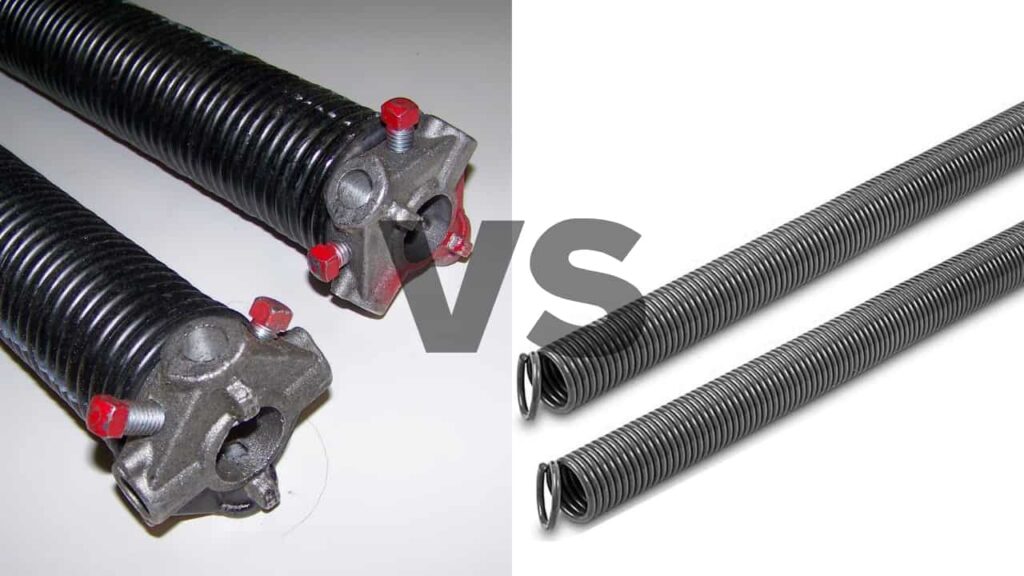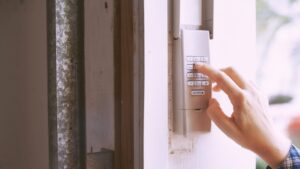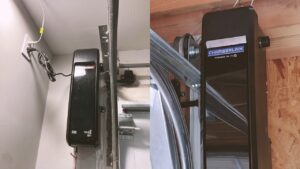Are you thinking about replacing the springs on your garage door but aren’t sure what type is right for your door?
You’re not alone. Springs are a key component in how your garage operates, and needing to replace them can present a challenge to homeowners.
Fortunately, there’s no need to worry as we’ll provide an overview of two common types of garage door springs, extension, and torsion, so you can make an informed decision when it comes time to replace your current setup!
Types of Garage Door Springs
There are two main types of garage door springs: extension and torsion. Each of these has further variants, each with its functionalities and limitations.
Let’s look at each of these in more detail to understand how they work and determine which spring is ideal for your garage door.
Extension Springs
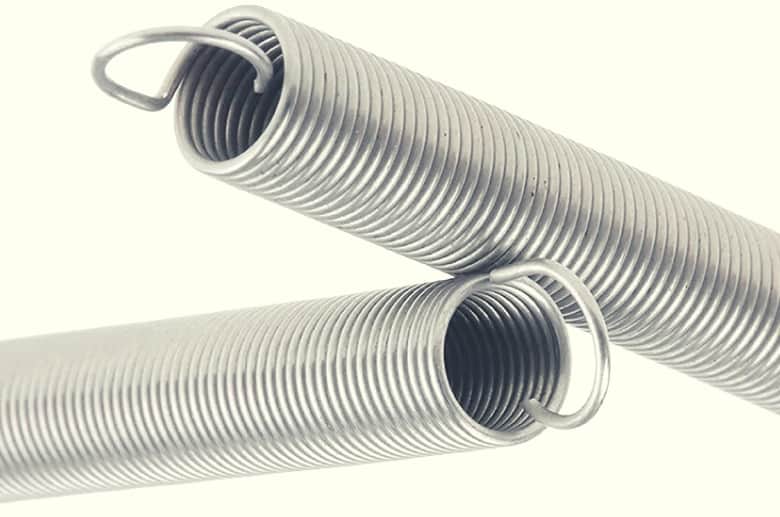
Extension springs for garage doors have been around for years and are usually located on the outer side of the horizontal tracks or mounted along the sides of the garage door. These springs extend (when the garage door opens) to create a counterbalance that supports the garage door.
Extension springs can typically be found in older houses’ garage doors, with one spring on each side to offer separate tension. They are particularly suitable for garage doors with low headroom, with insufficient ceiling space to install torsion springs.
Extension springs extend parallel to the horizontal tracks in sectional garage doors and pull the cables to counterbalance the garage door. In single-panel garage doors, the extension spring pulls against a pivot pin to help counterbalance the garage door.
Types of A Garage Door Extension Springs
Extension springs come with three different types of ends:
- Clipped Ends
Clipped ends are the most durable of the three used for garage doors weighing 200 pounds or more. They have a longer lifespan because the clips put little stress on the spring. However, they are challenging to replace. - Open-looped Ends
Extension springs with separated coils (that don’t touch each other) are called open-looped end extension springs.
These springs are used for taller garage doors with larger openings. The open end of these springs is used to attach them to an anchor bracket or an eye bolt.
Replacing extension springs with open-looped ends is easy because you don’t have to remove the pulley or even open the eye bolt. However, the problem with these springs is that you’ll need to replace the entire spring, even if only a part is damaged.
- Double-looped Ends
Double-looped ends are more durable and commonly used in low-headroom residential garage doors. Extension springs with double-looped ends have two coils that connect to the eye bolt and the pulley assembly. However, they are harder to replace.
Connect With A Garage Expert
Connect with local experts, Compare quotes, Get the best price.
Torsion Springs

Torsion springs are a type of mechanical spring that produces torque (rotational force). These springs are typically mounted to a metal shaft above the garage door.
The torque these springs generate is equally distributed along the metal shaft and transferred to the drums at each shaft’s end.
The flexible metal wires (connected to the drums) rotate as the spring generates torque, causing the door to open. The torsion springs unwind when the garage door opens to provide a counterbalance. When the garage door closes, these springs wind to balance it.
Types of Garage Door Torsion Springs
There are four primary types of torsion springs used in garage doors:
- Standard Torsion Spring
These springs are attached to a spring anchor bracket in the middle of the metal shaft. For lighter garage doors, one spring is enough, but heavier ones require two. If one of the springs fails, the other prevents the door from falling and causing property damage or injury. - EZ Set Torsion Spring
EZ set torsion springs are like standard torsion springs. However, they come with pre-installed winding cones and a locking mechanism that keeps them in place. These features make EZ set torsion springs much safer to install or replace, making them ideal for homeowners that prefer a DIY installation. - Steel Rolling Door Torsion Spring
Steel rolling door torsion springs fit inside the torsion barrel and are not visible. A winding wheel adjusts the spring tension on one side of the garage door, while a door opener connects to a sprocket assembly attached to the shaft to open the garage door. - Torque Master Torsion Spring
The safest of the four, the torque master torsion spring, is fixed inside the shaft. This spring, manufactured exclusively by Wayne Dalton, is wound with a winding cone (for older garage doors) or a wrench or socket (for newer garage doors) using a ratchet system.
Garage Door Spring Material Types
Garage door springs can be categorized into four types based on coating materials. Each of these materials offers a different set of properties and aesthetic appeal.
As a homeowner, you should know about these different types to decide which type of spring material best suits your garage door.
Oil-tempered
A high-carbon steel rod is heat-treated and used to form oil-tempered wires for both extension and torsion springs. Oil-tempered spring wires come with a black or blue finish and are quite durable.
Since the spring has an oil coating, prepare to get your hands dirty during installation.
There are two classes of oil-tempered wires:
Class 1: Typically used for residential garage doors, this class has a lower tensile strength.
Class 2: Used for commercial garage doors, this class has a higher tensile strength.
Hard Drawn
The manufacturing process of hard-drawn springs is similar to that of oil-tempered springs. However, these springs don’t go through heat treatment. Instead, they go through a series of dyes until they reach the required length and diameter.
BExtensionand torsion springs can be hard-drawn, bear continuous stress, and handle static loads quite well. They’re also quite affordable.
Galvanized
Both extension and torsion garage door springs use galvanized wires. These spring wires are hard-drawn (no heat treatment) and go through an extra step of getting a zinc coating. The zinc coating makes them corrosion-resistant and offers a metallic look, making the springs aesthetically pleasing and ideal for garage doors in humid environments.
Square Wire
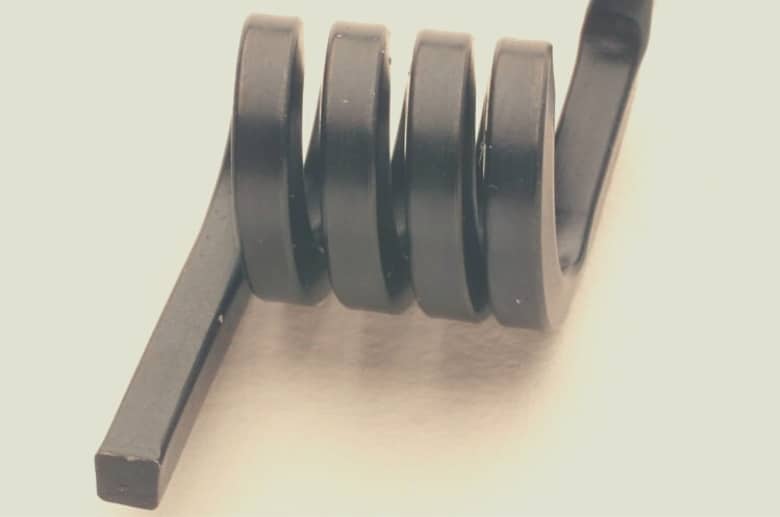
Square wire springs are usually used for heavy-duty, commercial garage door torsion spring systems. These springs pack more energy into a smaller volume. Square wire springs are used in garage doors that need something other than standard torsion springs, dual-shaft assemblies, or duplex assemblies.
Garage Door Spring Color Coding System
Have you ever noticed that garage door springs have colors on them?
DASMA created a standard color code scheme for garage door springs. These colors help identify the various spring properties.
Each type of spring has different color codes, i.e., torsion and extension springs.
Let’s take a look at them, one by one:
DASMA Color Code for Extension Springs
For extension springs, the color represents the garage door weight that two extension springs can lift. The code consists of 10 colors, which repeat for lightweight or extra-heavy garage doors.
The following is a DASMA color chart for extension springs:
| Color | Garage Door Weight in Pounds (Lightweight) | Garage Door Weight in Pounds | Garage Door Weight in Pounds (Extra-heavy) |
| White | 10 | 110 | 210 |
| Green | 20 | 120 | 220 |
| Yellow | 30 | 130 | 230 |
| Blue | 40 | 140 | 240 |
| Red | 50 | 150 | 250 |
| Brown | 60 | 160 | 260 |
| Orange | 70 | 170 | 270 |
| Gold | 80 | 180 | 280 |
| Light Blue | 90 | 190 | 290 |
| Tan | 100 | 200 | 300 |
DASMA Color Code for Torsion Springs
Unlike extension springs, torsion springs come with two color codes. One color code represents the wind direction, while the other represents the wire gauge.
The wind direction color code is as follows:
- Right-wound springs have red cones. Install them on the left side of your garage door.
- Left-wound springs have black cones. Install them on the right side of your garage door.
The wire gauge color code is as follows:
| Color | Wire Gauge in Inches |
| Orange | .120/.192/.273/.363/.485 |
| Light Blue | .125/.200/.283/.375/.4900 |
| Yellow | .135/.207/.289/.394/.500 |
| White | .139/.218/.295/.406/.531 |
| Red | .143/.225/.297/.422/.563 |
| Brown | .148/.234/.307/.431/.625 |
| Tan | .156/.238/.313/.438 |
| Green | .162/.244/.319/.453 |
| Gold | .177/.250/.331/.462 |
| Purple | .182/.257/.594 |
| Blue | .188/.263/.344/.469 |
How to Determine Garage Door Spring Size?
If you need to order new springs for your garage door, you need to know the correct measurement of your spring.
You must know the correct measurement to avoid ordering and installing the wrong spring on your garage door. This can result in spring failure, property damage, or severe injury.
Note: Measuring and weighing garage doors and springs can be quite risky. Always hire a professional garage door service to ensure accuracy and safety.
Connect With A Garage Expert
Connect with local experts, Compare quotes, Get the best price.
Measuring Torsion Springs
To purchase a torsion spring for your garage door, you must know its outer and inner diameters, length, and winding direction.
Measure your torsion spring by following the steps below:
Step 1. Use a measuring tape to measure the length of 20 coils of the spring.
Step 2. Divide this measurement by 20, and you’ve got the diameter of your spring.
Step 3. To note the inside diameter of your spring, check your stationary or winding cone.
Step 4. Find the spring’s length by disengaging it from the garage door and measuring its length from one end to the other.
To check its wind direction, note its cone color. Right-wound springs have red cones, while left-wound springs have black cones.
Measuring Extension Springs
To buy an extension spring for your garage door, determine the length and weight of the spring and the door.
To measure the spring length, close your garage door. Now use a measuring tape to measure the length of your spring from end to end.
Follow the steps below to measure the garage door weight:
Cut power to the garage door opener and disconnect the operator’s arm.
Step 1. Now remove the pin and remove both extension springs.
Step 2. Safely lower the garage door and lay it on the ground.
Step 3. Carefully place a weighing scale underneath the garage door.
Step 4. Take multiple readings to get an accurate approximation of your garage door weight.
Life Expectancy of Different Types of Garage Door Springs
Considering that most homeowners have either an extension or torsion spring system in their garage door, your garage door springs will survive for 5-7 years on average. Let’s look at the life expectancy of different garage door springs:
Extension Springs: Fixed to door brackets, extension springs are usually rated for 5,000 cycles, meaning they’ll last for more than 7 years for an average garage door.
Torsion Springs: Installed at the top of the garage door, torsion springs average about 10,000 cycles, meaning they will last more than 10 years with you.
EZ-set springs: A type of torsion springs, EZ-set springs are rated for 15,000 cycles and last up to 12 years for an average garage door.
The life expectancy of garage door springs is affected by the following factors:
- Spring quality
- Climate
- Wear & tear
- Weight of the garage door
In addition to the type of spring, proper maintenance significantly impacts the garage door springs’ lifespan. Homeowners who regularly maintain their garage door springs can expect them to last much longer than their average life expectancy.
If you want to increase the lifespan of your garage door springs, be sure to lubricate them regularly and check for signs of wear and tear. Hiring a professional garage door service to inspect and maintain your door springs regularly is also important to ensure safe and efficient operation and prevent unexpected failure.
Conclusion
The garage door’s overall mechanism is centered around springs.
Depending on your garage door type and usage, you can use an extension or torsion springs. While extension springs are cheaper, torsion springs provide more safety.
Remember, working with garage door springs comes with a risk of injury. That is why it’s best to consult a professional garage door service for measuring, replacing, or fixing garage door spring issues.

